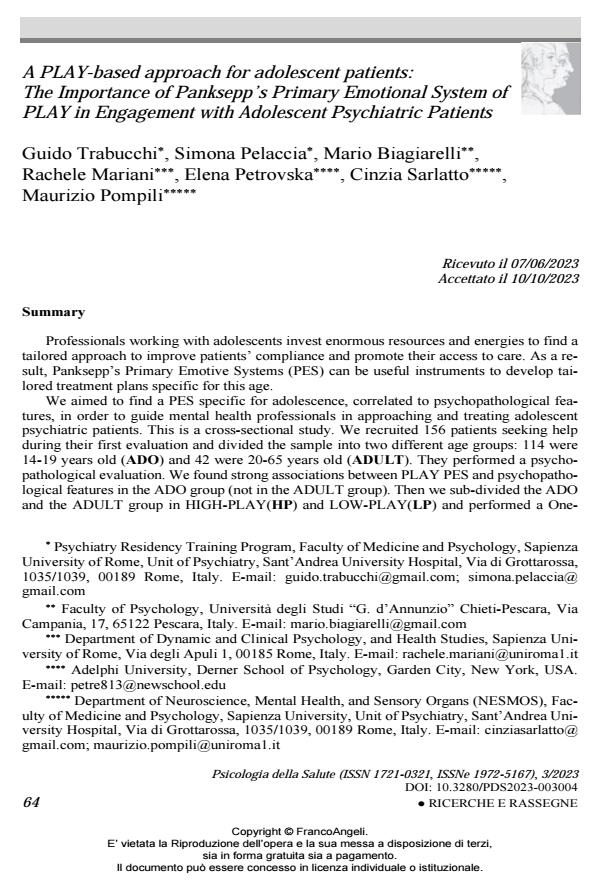A PLAY-based approach for adolescent patients: The Importance of Panksepp’s Primary Emotional System of PLAY in Engagement with Adolescent Psychiatric Patients
Journal title PSICOLOGIA DELLA SALUTE
Author/s Guido Trabucchi, Simona Pelaccia, Mario Biagiarelli, Rachele Mariani, Elena Petrovska, Cinzia Sarlatto, Maurizio Pompili
Publishing Year 2023 Issue 2023/3
Language English Pages 21 P. 64-84 File size 315 KB
DOI 10.3280/PDS2023-003004
DOI is like a bar code for intellectual property: to have more infomation
click here
Below, you can see the article first page
If you want to buy this article in PDF format, you can do it, following the instructions to buy download credits

FrancoAngeli is member of Publishers International Linking Association, Inc (PILA), a not-for-profit association which run the CrossRef service enabling links to and from online scholarly content.
Professionals working with adolescents invest enormous resources and energies to find a tailored approach to improve patients’ compliance and promote their access to care. As a re-sult, Panksepp’s Primary Emotive Systems (PES) can be useful instruments to develop tai-lored treatment plans specific for this age. We aimed to find a PES specific for adolescence, correlated to psychopathological fea-tures, in order to guide mental health professionals in approaching and treating adolescent psy-chiatric patients. This is a cross-sectional study. We recruited 156 patients seeking help during their first evaluation and divided the sample into two different age groups: 114 were 14-19 years old (ADO) and 42 were 20-65 years old (ADULT). They performed a psychopatholog-ical evaluation. We found strong associations between PLAY PES and psychopathological features in the ADO group (not in the ADULT group). Then we sub-divided the ADO and the ADULT group in HIGH-PLAY(HP) and LOW-PLAY(LP) and performed a One-Way ANOVA. In the ADO group, we found significant differences between HP and LP group psychopathological features, but the same was not found in the ADULT group. PLAY is an emotive system that is highly correlated with psychopathological features in our sample of adolescents seeking help. This correlation was not found in ADULT patients. For these results, we suggested PLAY can be a useful instrument to treat help-seeking adoles-cents with mental health issues.
Keywords: adolescent psychiatry, affective neurosciences, primary emotive systems, psy-chopathology, therapeutic engagement.
Guido Trabucchi, Simona Pelaccia, Mario Biagiarelli, Rachele Mariani, Elena Petrovska, Cinzia Sarlatto, Maurizio Pompili, A PLAY-based approach for adolescent patients: The Importance of Panksepp’s Primary Emotional System of PLAY in Engagement with Adolescent Psychiatric Patients in "PSICOLOGIA DELLA SALUTE" 3/2023, pp 64-84, DOI: 10.3280/PDS2023-003004